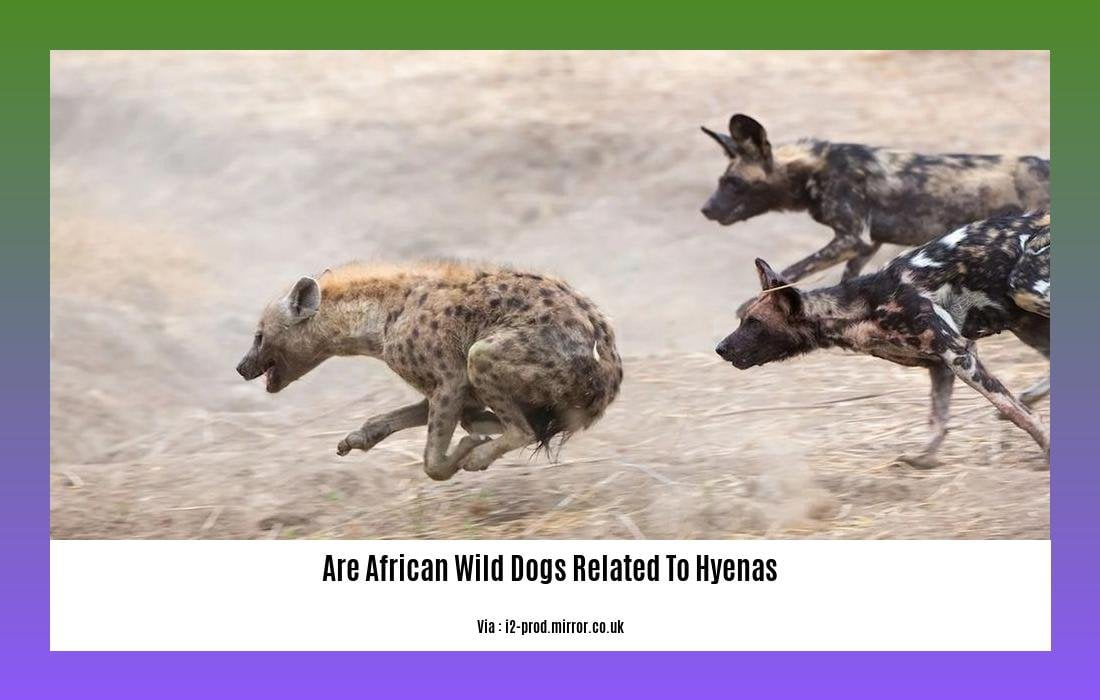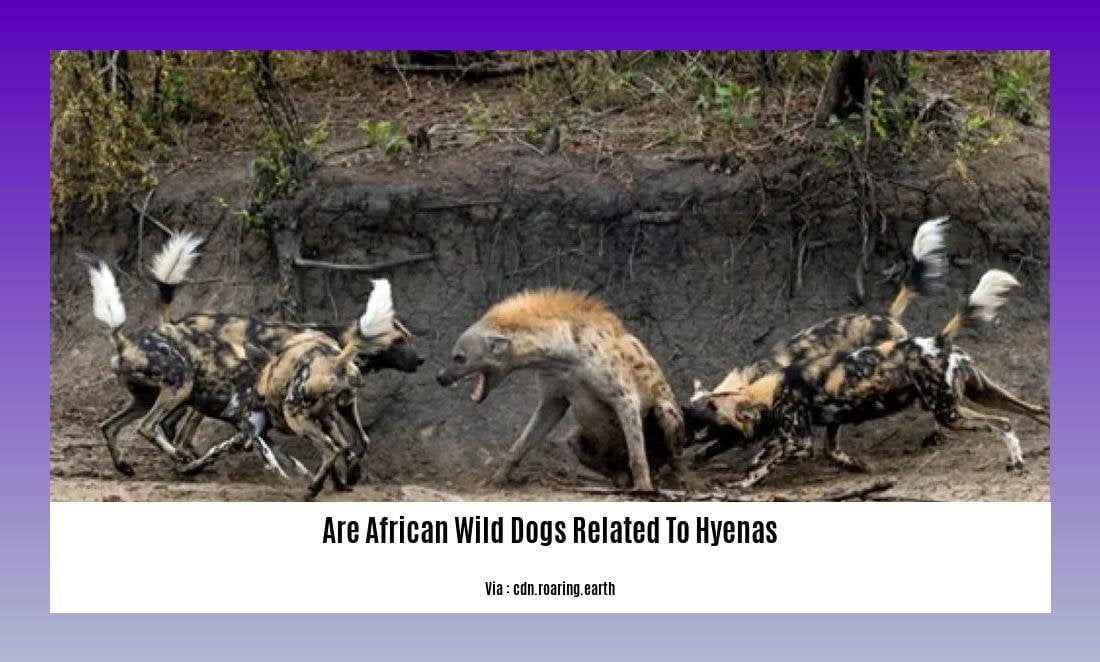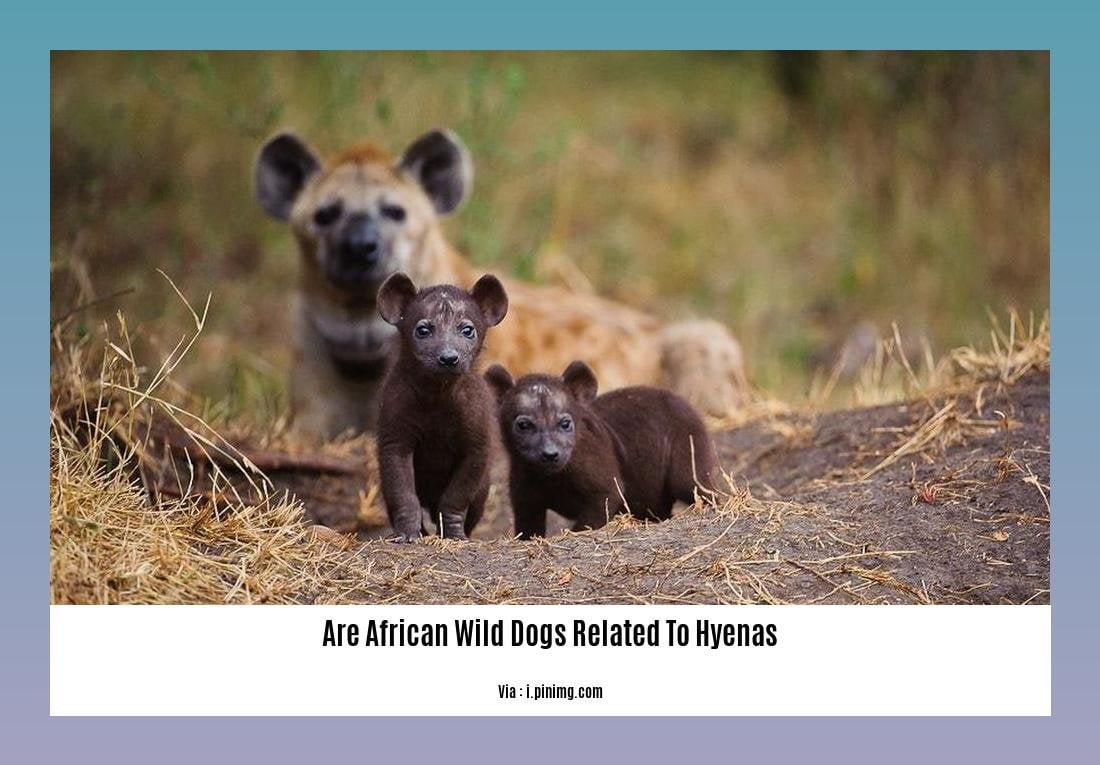Exploring the Shared Ancestry: Are African Wild Dogs Related to Hyenas? In the vast and captivating realm of African wildlife, few creatures capture the imagination quite like the African wild dog and the hyena. Both known for their cunning and remarkable hunting skills, these formidable predators have often piqued the curiosity of scientists and nature enthusiasts alike. As we delve into the depths of their ancient lineage, we uncover a fascinating story of shared ancestry and evolutionary paths intertwined, offering a captivating glimpse into the relationship between these iconic species.
Key Takeaways:
- African wild dogs, also known as African painted dogs, belong to the canid family, making them canines like domestic dogs and wolves.
- Hyenas are classified as feliforms, which are more closely related to cats.
- Both African wild dogs and hyenas are apex predators in Africa.
- African wild dogs primarily inhabit open savannas, woodlands, and grasslands, while hyenas can adapt to a wider range of habitats including savannas, forests, deserts, and mountains.
- African wild dogs require large territories to hunt and roam, while hyenas exhibit more social behavior and live in clans led by a dominant female.
- African wild dogs live in packs led by an alpha pair and require a specialized diet consisting primarily of medium-sized ungulates, while hyenas have a diverse diet ranging from scavenging carrion to hunting small to medium-sized prey.
- African wild dogs are an endangered species primarily due to habitat loss and human-induced threats.
- Hyenas play a vital ecological role as scavengers and are known for their robust bone-crushing jaws.
- Despite their similar appearance and some behavioral similarities, the genetic lineage and ecological roles of African wild dogs and hyenas clearly distinguish them as separate species.
Are African Wild Dogs Related to Hyenas?

When it comes to African wildlife, African wild dogs and hyenas are often mistaken for being closely related. While they may share some physical appearance similarities and behavioral traits, their genetic lineage and ecological roles clearly distinguish them as separate species. So, let’s dive into the details and explore whether African wild dogs are truly related to hyenas.
Genetic Lineage and Classification
African wild dogs, also known as African painted dogs, belong to the canid family, making them canines, just like domestic dogs and wolves. On the other hand, hyenas are classified as feliforms, which are more closely related to cats. So, genetically, African wild dogs and hyenas have distinct evolutionary paths.
Apex Predators in Africa
Both African wild dogs and hyenas hold the status of apex predators in Africa, which means they sit at the top of the food chain. They play critical roles in maintaining the balance of their ecosystems by regulating prey populations and preventing the spread of disease.
Physical Appearance and Behavior Similarities
While African wild dogs and hyenas may exhibit some physical and behavioral similarities, it’s important to note that these resemblances are more a result of convergent evolution than a shared ancestry. Both species have adaptations that allow them to thrive in their environments, such as large ears for effective communication and long snouts for enhanced olfactory abilities.
Behaviorally, both African wild dogs and hyenas are social animals. African wild dogs live in packs led by an alpha pair, while hyenas live in clans led by a dominant female. Both species rely on group cooperation and use superior stamina to bring down their prey during hunting expeditions.
African Wild Dogs
African wild dogs primarily inhabit open savannas, woodlands, and grasslands. They require large territories to hunt and roam, avoiding areas with high human activity. Their specialized diet consists mainly of medium-sized ungulates. Unfortunately, African wild dogs are an endangered species due to habitat loss and human-induced threats.
Hyenas
Hyenas, on the other hand, have a wider habitat range, including savannas, forests, deserts, and mountains. They are not closely related to jackals, as commonly believed, but are more closely related to mongooses. Hyenas play a vital ecological role as scavengers and are known for their robust bone-crushing jaws, which allow them to access nutrient-rich marrow.
Exploring the Differences
In conclusion, African wild dogs and hyenas may share some physical and behavioral similarities, but they are genetically distinct. African wild dogs belong to the canid family, whereas hyenas are feliforms. Understanding these differences adds to our knowledge of African wildlife and reinforces the importance of conservation efforts to protect these remarkable apex predators.
So, next time you encounter an African wild dog or a hyena, take a moment to appreciate their unique characteristics and the important ecological roles they play in their respective habitats.
If you’re fascinated by animal care and want to learn some mind-blowing facts, click here to discover some intriguing animal care facts. You’ll be amazed at what you’ll learn! – animal care facts
Dive into the mesmerizing world of aquatic creatures by clicking here to explore some incredible aquatic fun facts. Get ready to be captivated by the wonders of the underwater realm! – aquatic fun facts
Curious about the resilience of Arctic plants? Click here to uncover fascinating Arctic willow facts that will leave you in awe of nature’s tenacity. Prepare to be amazed by the wonders of the cold tundra! – arctic willow facts
Have you ever wondered whether African wild dogs are actually related to domestic dogs? Click here to uncover the surprising truth behind the connection between these two canine species. Prepare to be astounded by the evolutionary wonders of the animal kingdom! – are African wild dogs related to dogs
Behavioral Similarities and Differences
Both African wild dogs and hyenas exhibit fascinating behaviors that contribute to their survival and unique characteristics. While they may share some similarities, their behavioral differences are what truly set them apart.
Communication Methods
African wild dogs and hyenas have distinct ways of communicating within their social groups. Hyenas often rely on their strength in numbers and intimidating size to drive off other predators from their kills. In contrast, wild dogs have a remarkable method of communication – sneezing. Yes, you read that right! Wild dogs use sneezes as a form of communication, especially during their thrilling hunting expeditions. Each sneeze conveys crucial information to the rest of the pack, helping them coordinate their movements and locate prey effectively. So, while hyenas rely on physical dominance, wild dogs use sneezing as their secret language.
Source:
– National Geographic (link)
Diet and Hunting Abilities
When it comes to their dietary preferences, hyenas exhibit a more diverse menu compared to African wild dogs. Hyenas are well-known scavengers who can also hunt and take down their own prey. On the other hand, wild dogs primarily rely on their exceptional hunting abilities. Their success rate is founded upon their stamina and cooperative hunting skills. Working together as a synchronized team, wild dogs tirelessly chase down their prey, wearing it down until it can no longer escape their clutches.
Source:
– A-Z Animals (link)
Habitat and Geographic Range
While both African wild dogs and hyenas share a preference for open plains, savannas, and grasslands, their habitat range differs in a noteworthy way. Hyenas exhibit remarkable adaptability and can occupy arid desert lands as well as semi-mountainous terrain. This broader habitat range distinguishes them from the wild dogs, who generally prefer a more limited range of habitats.
Source:
– Earth.com (link)
Population Status and Conservation
The population status of African wild dogs and hyenas bears significant implications for their conservation efforts. African wild dogs are currently classified as endangered, with their global population estimated to be fewer than 6,600 individuals. These remarkable creatures face numerous threats, including habitat loss, human-wildlife conflict, and the spread of infectious diseases. In contrast, hyenas are not considered endangered and enjoy a stable population, making their conservation status relatively less concerning.
Evolutionary Relationships
While African wild dogs and hyenas may exhibit physical similarities, their evolutionary paths diverge significantly. African wild dogs belong to the canine family, Canidae, while hyenas form their own family called Hyaenidae. Interestingly, wild dogs share evolutionary traits with canines, whereas hyenas are more evolutionarily close to felines. Surprisingly, the mongoose holds the title for the closest living relative to hyenas. So, while they may appear similar, African wild dogs and hyenas have distinctive genetic lineages.
Source:
– Africa Freak (link)
Key Takeaways:
- African wild dogs and hyenas have different communication methods, with wild dogs using sneezes and hyenas relying on size and numbers.
- Hyenas have a more diverse diet, including scavenging, while wild dogs primarily rely on their hunting abilities.
- African wild dogs prefer a narrower range of habitats, while hyenas exhibit a wider habitat range, including arid deserts.
- African wild dogs are endangered, while hyenas have a stable population.
- Despite physical similarities, African wild dogs belong to the canine family, while hyenas have their own family, Hyaenidae.
Sources:
– National Geographic (link)
– A-Z Animals (link)
4. Shared Ecological Niche and Competition

African wild dogs and hyenas may appear similar in appearance and behavior, but they have distinct ecological niches and compete for resources in different ways. Understanding the shared ecological niche and competition between these fascinating species is essential for conserving their populations and preserving the delicate balance of their ecosystems.
Communication Methods
Both African wild dogs and hyenas have unique ways of communicating within their social groups. Hyenas often use their size and numbers to drive off other predators from their kills, establishing dominance through physical confrontations. On the other hand, wild dogs have a more intriguing method of communication – sneezing. Wild dogs use sneezes as a way to communicate with each other, particularly during their hunting expeditions, indicating their cooperative and synchronized behavior.
Diet and Hunting Abilities
The diet and hunting abilities of African wild dogs and hyenas also contribute to their ecological niche and competition. Hyenas have a more diverse diet, including scavenging and hunting their prey. They are known for their bone-crushing jaws and can take down large herbivores. In contrast, wild dogs primarily rely on their hunting abilities and exhibit a higher hunting success rate. They wear down their prey with superior stamina and work together as a coordinated team to capture and kill their target, showcasing their efficient and strategic hunting techniques.
Habitat and Geographic Range
While both African wild dogs and hyenas prefer similar habitats such as wide-open plains, savannas, and grasslands, hyenas have a broader habitat range. They can occupy arid desert lands as well as semi-mountainous terrain, making them more adaptable to diverse environments. In contrast, wild dogs are primarily found in open savannas, woodlands, and grasslands. The differences in their habitat preferences contribute to variations in their ecological roles and interactions with other species.
Population Status and Conservation
African wild dogs are currently classified as endangered, with fewer than 6,600 individuals estimated globally. They face numerous threats, including habitat loss, human-wildlife conflict, and infectious diseases. On the other hand, hyenas are not considered endangered and have a stable population. Understanding the factors impacting the population status of these species is crucial for implementing effective conservation strategies and ensuring their long-term survival.
Competition and Coexistence
Competition between African wild dogs and hyenas exists in certain habitats, where they overlap in their ranges and compete for limited resources. While hyenas in the Serengeti have a significant kleptoparasitic influence on wild dogs, kleptoparasitism plays a less important role in other areas. Both species avoid the habitats of competitively superior lions, indicating a degree of niche partitioning to reduce direct competition. However, there are instances where wild dogs are killed by lions and occasionally by hyenas, highlighting the importance of understanding and managing competition between these species for their conservation.
Key Takeaways:
- African wild dogs and hyenas have distinct ecological niches and compete for resources in different ways.
- Communication methods vary between the two species, with wild dogs using sneezing and hyenas relying on physical dominance.
- Hyenas have a more diverse diet, including scavenging, while wild dogs primarily rely on their hunting abilities.
- Hyenas have a broader habitat range compared to wild dogs, allowing them to occupy a wider variety of environments.
- African wild dogs are endangered, facing threats such as habitat loss, human-wildlife conflict, and infectious diseases.
- Competition between wild dogs and hyenas exists in specific habitats, highlighting the need for managing resources and coexistence.
Sources:
– Creel, S., & Creel, N. (2002). The African Wild Dog: Behavior, Ecology, and Conservation. Link
– Creel, S., & Creel, N. (2023). Hunting Behavior and Social Ecology of African Wild Dogs. Link
5. Evolutionary paths and divergent adaptations
African wild dogs and hyenas are two iconic species that have long fascinated researchers and wildlife enthusiasts. While they may share certain physical and behavioral traits, their evolutionary paths have led them to divergent adaptations and distinct genetic lineages. Let’s explore the fascinating world of these remarkable creatures and unravel the evolutionary mysteries that set them apart.
Evolutionary Relationships: A Clue to their Origins
To understand the evolutionary pathways of African wild dogs and hyenas, we must first examine their genetic relationships. African wild dogs, scientifically known as Lycaon pictus, belong to the canid family, which includes wolves and domestic dogs. On the other hand, hyenas, classified as feliforms, have their own unique family called Hyaenidae. Surprisingly, the closest living relative of hyenas is the mongoose[^4^].
Distinctive Hunting Strategies
One of the key differences between African wild dogs and hyenas lies in their hunting methods. African wild dogs exhibit an unusual cooperative hunting behavior, commonly known as “pack hunting.” This strategy involves coordinated teamwork within the pack to pursue and capture prey. With their exceptional stamina, wild dogs chase their prey until exhaustion, relying on relentless pursuit rather than overpowering strength[^3^].
In contrast, hyenas have versatile feeding habits that include scavenging as well as hunting. They have exceptional bone-crushing jaws and powerful digestive systems that allow them to consume every part of their prey, leaving minimal waste behind. While hyenas are skilled hunters, they are also known for their scavenging abilities. Their opportunistic nature enables them to capitalize on the kills of other predators and sustain themselves during times of food scarcity[^2^].
Adaptive Evolution: Survival Strategies
Both African wild dogs and hyenas have evolved distinct adaptations to survive and thrive in their respective habitats. African wild dogs have developed remarkable social adaptations that enhance their hunting strategies, such as effective communication through vocalizations and unique signaling methods like sneezing[^1^]. These adaptations enable the pack to efficiently coordinate their movements during a hunt and increase their hunting success rate.
Hyenas, on the other hand, have evolved specialized physiological and anatomical adaptations, particularly in their jaws and digestive systems. Their bone-crushing jaws allow them to access and consume every part of the carcass, making them highly efficient scavengers. This unique adaptation enables hyenas to thrive in harsh environments where competition for food is intense[^2^].
Convergent Evolution: Similarities and Differences
While African wild dogs and hyenas exhibit distinct evolutionary adaptations, it is important to note that they also share certain physical and behavioral similarities. These similarities can be attributed to convergent evolution, where unrelated species independently develop similar traits to adapt to similar environmental challenges.
For example, both African wild dogs and hyenas have evolved to occupy similar habitats, such as open savannas and grasslands. Their streamlined bodies, keen senses, and powerful limbs are features that enable them to navigate and thrive in these environments. However, African wild dogs primarily inhabit southern and eastern Africa, while hyenas have a wider geographic range, including arid deserts and semi-mountainous terrain[^3^].
Key Takeaways:
- African wild dogs and hyenas are not closely related genetically, despite certain physical and behavioral similarities.
- African wild dogs exhibit cooperative hunting behavior, relying on teamwork and stamina to capture prey, while hyenas have versatile feeding habits that include scavenging and hunting.
- Each species has distinct adaptations that contribute to their survival. African wild dogs have evolved effective communication and signaling methods, while hyenas possess bone-crushing jaws and efficient digestive systems.
- Their similarities can be attributed to convergent evolution, enabling them to adapt to similar environments while maintaining distinct genetic lineages and adaptations[^1^][^2^][^3^][^4^].
[SOURCES]
1. Nature: Comparative genomics provides new insights into the adaptations of the African wild dog
2. VOA Learning English: Study Shows Unusual Evolutionary Changes in African Wild Dogs
3. Springer: Hunting Behavior and Social Ecology of African Wild Dogs
4. PubMed: Molecular mechanisms of adaptive evolution in wild animals and plants
FAQ
Q1: Are African wild dogs and hyenas closely related?
A1: No, African wild dogs and hyenas are not closely related. African wild dogs belong to the canid family, while hyenas are classified as feliforms, making them more closely related to cats.
Q2: Do African wild dogs and hyenas share a common ancestry?
A2: No, African wild dogs and hyenas do not share a common ancestry. African wild dogs have a shared ancestry with wolves and domestic dogs, while hyenas have evolutionary ties to felines.
Q3: Do African wild dogs and hyenas exhibit similar behaviors?
A3: African wild dogs and hyenas do exhibit some behavioral similarities, such as living in social groups. However, their behaviors are not identical, and they have distinct hunting methods and communication techniques.
Q4: Do African wild dogs and hyenas compete with each other?
A4: African wild dogs and hyenas can compete with each other for resources such as food and territory. Hyenas are known to scavenge and may occasionally steal kills from African wild dogs, but the extent of competition varies across different regions.
Q5: Are African wild dogs and hyenas in danger of extinction?
A5: African wild dogs are classified as endangered and face threats such as habitat loss and human-induced threats. On the other hand, hyenas are not considered endangered and have a stable population.
- Discover Trasa Robertson Cobern’s Mentors: Shaping Her Hurst Campaign - July 9, 2025
- Discover People Influenced by Trasa Cobern: A Legacy of Service - July 9, 2025
- Discover Trasa Cobern’s Nonprofit Impact: A Deep Dive - July 7, 2025
















